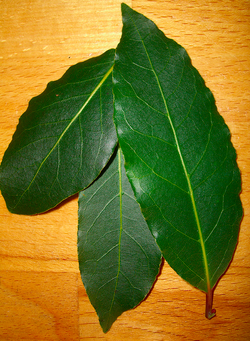
The bay leaf comes from the bay tree (Laurus nobilis), family Lauraceae. It is also known as sweet bay or sweet laurel.
Origins[edit | edit source]
The bay tree is thought to have originated in Asia Minor. It has long been grown in the Mediterranean region. It is now grown in many areas of the world, including North Africa, Australia and the warmer regions of North America.
Tree characteristics[edit | edit source]
The bay tree grows to a height of around 7.5 metres (25 feet) in cool climates and up to 18 metres (60 feet) in warmer climates. It prefers growing in valleys that are sunny and have rich soil.
The leaves are stiff and leathery, oblong in shape and pointed at the end. They have a shiny top and are dull underneath.
Using bay leaves[edit | edit source]
Bay leaves are principally used for culinary purposes. However, they do have several medicinal uses, such as forming part of a rub that can ease inflammation or rheumatic joint pain. It is advised to follow an approved recipe for using bay in this manner.
The bay leaf can also be used in aromatherapy. It is thought to help with relieving headaches and helping memory recall.
When the bay leaf is broken open, it releases a pungent aroma. It contains the essential oils geraniol, cineol, eugenol and terpenes. It also contains glyceryl laureate, tannic acid and bitters.
Culinary use[edit | edit source]
In terms of culinary use, the bay leaf has numerous uses, both fresh and dry. The bay leaf is very important for French cuisine and certain Mediterranean recipes. One of its most well-known uses is as a part of bouquet garni, which is a French seasoning consisting of fresh herbs tied into a bundle and added to various French dishes, usually soups, stews and bean dishes.
Some common uses for the bay leaf include:
- Improving the flavour of sauces, especially creamy or flour and dairy based sauces
- Adding to water when cooking rice, pulses and lentils
- As part of pickling spices.
Bay leaves continue to release their flavour even after hours of cooking.
Insect deterrent[edit | edit source]
A bay leaf added to stored flour, dried rice or grains, can deter weevils and other insects.
Substitutes[edit | edit source]
The larger leaf of the the American bay (Umbelluliaria californica) can be used in place of the bay leaf but in much smaller quantities because it has a stronger flavour.
Never use the cherry laurel (Prunus laurocerasus) for culinary purposes; it is poisonous.
Bouquet garni[edit | edit source]
It is easy to make your own bouquet garni:
- Buy or pick the following fresh herbs: 3 sprigs chervil, 3 sprigs parsley, 1/2 bay leaf and 2 sprigs thyme.
- Tie the fresh herbs together with string. Place into the recipe you're cooking.
- If using dried herbs, tie the stems of dried herbs inside muslin or cheesecloth.